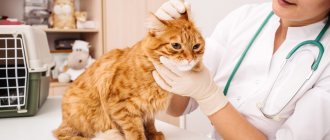Normal temperature for cats
The normal body temperature for humans is approximately +36.6 degrees Celsius. Of course, its indicators may vary depending on the time of day, the physical condition of the person at the time of its measurement and many other factors.
The physiological body temperature of cats is higher than that of humans, and averages +38 °C. In this regard, a cat’s ears will almost always seem hotter than their own body to a person.
It is worth mentioning separately about hairless cat breeds, for example, the same Sphynx. They may appear much hotter than a furred animal. This is primarily due to the fact that representatives of hairless breeds spend much more energy due to their inherent accelerated metabolism. Therefore, despite the fact that sphinxes may seem very hot to the touch, in most cases this is a physiological norm for the animals themselves.
How to tell if your cat's ears are hot
Of course, an experienced cat lover can determine by touch that his pet’s ears are much hotter than usual. And, naturally, such a phenomenon cannot but cause concern for the owner. Hot ears alone cannot serve as a reliable sign of illness in an animal. The cat's health status should be assessed using a whole range of different indicators. So, when an animal is sick, in addition to hot ears, the following signs may be present:
- change in the color of the auricle (with illness, it acquires a bright red tint);
The owner can notice redness of the ear with the naked eye
- increased temperature in the armpits and oral cavity;
- nose that is hot and dry to the touch;
- lethargy, apathy of the animal, refusal to eat.
If, along with hot ears, the cat has at least a few of the above signs, then only this is the basis for suspicion of the pet’s ill health.
What to give a cat for hyperthermia
If you suspect your pet's hot ears are a sign of hyperthermia, take his temperature using a rectal thermometer.
It should be noted that the normal body temperature of cats is within 38 degrees, that is, higher than that of humans. At the same time, for representatives of certain breeds, for example, hairless cats, 41.5 °C is considered the norm.
If, when measuring your pet's temperature, it turns out that it is higher than normal, you need to take care of drinking plenty of fluids. As a rule, sick animals refuse food, but drink more than usual. Therefore, the cat should always have clean water at room temperature available.
As first aid, you can use a medicinal plant such as echinacea. The tincture effectively reduces fever, copes with various infections in the body, and also improves immunity.
In this case, the dosage must be strictly observed. Experts recommend using no more than 10 drops per 10 kilograms of weight. In addition to echinacea, you can use another medicinal plant - astragalus. The dosage is similar.
To boost immunity, the veterinarian may recommend a vitamin complex enriched with vitamin C. This is necessary so that the weakened immune system can recover and perform its direct function - to fight various infections.
Why does a cat have hot ears?
There are many reasons why a cat's ears become hot. However, all of them can be combined into two groups:
- Physiological reasons. The temperature of the ears is influenced by many external factors, for example, being in a hot and stuffy room, or prolonged physical activity of the pet. Sometimes ordinary stress can provoke such hyperthermia. Newborn kittens and pregnant cats always have very hot ears.
- Pathological reasons. The most common among them are: infection with ear mites;
- colds;
- infectious diseases of the ears, for example, otitis media;
- injuries and hematomas;
- viral infections.
Physiological causes of fever
During sleep, the nose dries out and its temperature rises. But as soon as the cat wakes up and washes itself, the surface of the nose returns to its normal state.
In a stuffy room with dry air, pets will also have a hot and dry nose. Regular ventilation of the house will make the living conditions comfortable for both owners and animals.
The nose and ears can become hot if the body is dehydrated; there should always be fresh and clean water in the cat's drinking bowl. Walking in the sun can also lead to a dry nose and a temporary increase in body temperature.
Hot noses and paws are observed in cats after giving birth, which is a stressful situation for her. On the day of contractions, a pregnant cat's breathing rate and pulse increase, and the nose and other parts of the body gradually become hot. Some time after lambing, the cat comes to its senses and its condition returns to normal. Similar stress occurs in a cat after sterilization.
How to identify the cause of hot ears in a cat
Pathologies, in addition to elevated ear temperature, always manifest themselves with additional symptoms, which you should pay attention to first:
- Ear mite. Infection of cats with ear mites, which in veterinary practice is called otodectosis, is a fairly common phenomenon. It is worth noting that otodectosis can affect only one ear - in this case, the symptoms will be characteristic of only one ear. The disease is accompanied by: severe hyperthermia of the ears;
- presence of foul-smelling dark discharge from the ears;
- the formation of ulcers on the inner surface of the ear;
- restless behavior of the pet, expressed in attempts to comb its ears.
The owner of the animal can see with the naked eye not the ear mites themselves, but their metabolic products
- change in ear color (its inner side becomes red), local hyperthermia;
- increased ear temperature;
When a hematoma develops, the auricle swells and becomes red or bluish
- lethargy;
Video: otodectosis in a cat
How to perform a home ear examination
If a cat has hot ears, then he should have his auricle examined, the condition of which can be used to judge whether the animal has a particular pathology.
You can do this as follows:
- It is necessary to calm the pet. It is impossible to conduct an examination when the cat is in an aggressive or excited state.
- If touching the ear causes pain to the animal, it must be secured in a diaper or towel to protect itself from sharp claws.
A protective bag is a convenient device that will protect the owner from the sharp claws of the pet when examining it.
- The examination begins from the outside of the ear, it is noted whether there are any ulcers, scratches, scratches, or hair loss on it.
- Next, the inside is inspected; to do this, the animal’s ear should be slightly bent.
- Under no circumstances should you try to insert foreign objects deep into your cat's ear. This is fraught with damage to the hearing aid, infection, and this manipulation can cause an attack of acute pain in the pet.
- When examining the inside of the ear, you should pay attention to the color of the skin, the presence of discharge, ulcers and microtraumas.
How to measure a cat's temperature
It is almost impossible to reliably know whether a cat’s general body temperature is elevated by external signs. To do this, you should use the appropriate medical instruments - a thermometer.
Measure your pet's temperature like this:
- It is necessary to secure the animal with a towel or diaper.
- The tip of the thermometer must be lubricated with Vaseline or baby cream.
- The tip of the thermometer is placed into the cat's anus using rotational movements to a depth of no more than 1 cm.
- During insertion of the thermometer, you should hold your pet tightly, since this procedure is usually very unpleasant for him.
- When measuring temperature, the thermometer should be at an angle of approximately 30 degrees.
- After measurement, the thermometer must be washed and disinfected.
Measuring a cat's temperature takes on average about 2 minutes.
Video: how to measure a cat's temperature rectally
Once I had the opportunity to measure the temperature of my cat. According to the description, this is a simple matter, but in reality the process is very complex. First, you need an assistant. We kept the cat together; I definitely wouldn’t have been able to handle it alone, because the animal definitely wouldn’t lie quietly with a thermometer. Secondly, we were unable to wrap the hind legs securely right away, since we had to insert a thermometer under the tail, and we additionally wrapped them after inserting the thermometer. And thirdly, we also had to wrap up the cat’s face because she tried to bite. The animal’s suffering was not in vain, because the cat was really sick. Her temperature was closer to 40 degrees, and I quickly took her to the vet.
Signs of illness
If owners notice a hot nose on their cat, they should be concerned as soon as possible and make an appointment with a doctor when one of the following symptoms is added:
- the animal does not drink water for a long time;
- the cat refuses to eat;
- avoids owners, hides, does not want to play;
- shows aggression, runs around the apartment, behaves irritably;
- the animal, on the contrary, becomes apathetic and falls into melancholy;
- there are signs of a cold: sneezing, red eyes;
- Fluid flows from the nose and discharge occurs.
Important! Such signs, along with elevated ear temperature, may indicate a painful condition that requires veterinary intervention.
Viral infection
If the cat's immune system is fighting an infection, its temperature may rise above normal. If your cat has warm ears, there may be other signs of a viral infection: lethargy and decreased appetite.
Viral diseases include acute pathological changes associated with the presence of microorganisms in the blood of an animal. Pathogenic organisms cause various serious consequences that significantly undermine the health of the pet.











